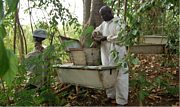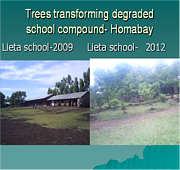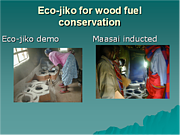Kenya National Committee of IUCN Members
01 August 2012 | Article
The most notable achievement is the formation and formal recognition of Kenya IUCN National Committee. At its 75th meeting, the IUCN Council, meeting held in Gland 18-20th November 20101 granted formal recognition to Kenya IUCN National Committee of IUCN Members.
This was part of the sensitization process by the IUCN ESARO office following several meetings but notably the first meeting of the IUCN Members’ for Eastern and Southern Africa convened at the IUCN Eastern and Southern Africa Regional Office (ESARO) in Nairobi, Kenya on October 22nd to 23rd 2009. In addition to the Members, representatives from the IUCN Commission, 2 (two) IUCN Councilors for Africa and technical staff from IUCN ESARO Secretariat attended the meeting and were instrumental in providing information to members.
Following this meeting Kenya elected its office bearers and developed it National Committee Constitution. The committee was established as a non-profit association of IUCN Members as forum of Members, as of 16 October 2009. With this the committee was formally recognized and also engaged in “One Programme Approach”.
After its formal recognition the committee has been involved in the following:
- facilitating cooperation among Members;
- coordinating with other components of IUCN;
- promoting participation of Members in the Programme and Governance of IUCN; and
- issuing statements relevant to the objectives of IUCN (on behalf of the Committee).
SPECIFIC ACTIVITIES AND PROJECT HIGHLIGHTS
Facilitate cooperation among Members:
• Members have cooperated in areas of biodiversity conservation as stakeholder in various forums
• Sharing of information especially through e-mails
Coordination with other components of IUCN
• Sharing of information such as newsletters, among the Members
• Coordination with the ESARO regional committee particularly because the Kenya National committee is also Vice Chair for the Regional Committee
Promote participation of Members in the Programme and Governance of IUCN
• Adopted Conservation of biodiversity in line with “one programme approach”. Details of this is highlighted below
Issue statements relevant to the objectives of IUCN (on behalf of the Committee)
• Has not issues statements through the media but have participated in a conflict resolution meeting that was spearheaded by IUCN ESARO office in Nairobi regarding management of Mt. Elgon as a transboundary resource between Kenya and Uganda (Kenya Wildlife Service). This is under Livelihoods and ecosystems in forests Programme, where IUCN ESARO office facilitates local communities and stakeholders to support sustainable management of the landscape in Mt. Elgon.
IUCN Core Programme Area: Conserving biodiversity - “One Programme Approach”
• Worked together with a partner from Uganda (Nature Uganda) and WWF Tanzania responded to the core programme area of Conserving Biodiversity. With support from WWF Sweden through WWF Eastern and Southern Africa Regional Programme Office (ESARPO), the Wildlife Clubs of Kenya (WCK), during the reporting period implemented the Lake Victoria Catchment Environmental Education Programme (LVCEEP). LVCEEP covers Homabay and Transmara Districts and, Nandi South area in Kenya, in Tanzania the project is based in Musoma and Tarime Districts within the Mara river basin while in Uganda the areas of coverage are Kyejonjo and Masaka regions in the Katonga river basin
Kenya Marine and Fisheries Research Institute (KEMFRI) has the following projects implemented in line with IUCN:
1. Agulhas and Somali Current Large Marine Ecosystems (ASCLME) Project
2. South West Indian Ocean Fisheries Project (SWIOFP)
3. Fishery Management and Sustainable Coastal Environment Development Project (KCDP)
4. Fishery Management and Sustainable Coastal Environment Development Project (KCDP)
5. Resilience and adaptation of mangroves and dependent communities in the WIO region to the impacts of climate change
6. Africa Monitoring of Environment for Sustainable Development (AMESD)
7. Global markets and the livelihoods of coastal communities in the WIO Region: Implications for coastal management.
These following results were achieved in general for all the projects: National META data sets; ASCLME TDA draft reports; trainings undertaken; national training plan in place; MSc trainings accomplished; 3 new prawn species discovered; data to support development of fishery management plan; project management units established; component activities initiated; mangrove cover change maps; mangrove data and information; nurseries established; trainings; national AMESD Proposal submitted to EU for funding accepted social data and information on consumption patterns and emerging conservation and management policies, regulations and legislative frameworks.
Environment Liaison Centre International (ELCI) continues to implement programmes in the fisheries sector, with emphasis on the Lake Victoria fisheries: ELCI’s programming objectives have been around increasing participation of fishing communities around Lake Victoria in the governance and management of the sector; enhancing the capacity of Lake Victoria fishing communities to engage in sustainable fish-based enterprises; and enhancing coordination among key stakeholders in the fisheries sector at county, national and regional (East Africa) levels to influence sector policies.






